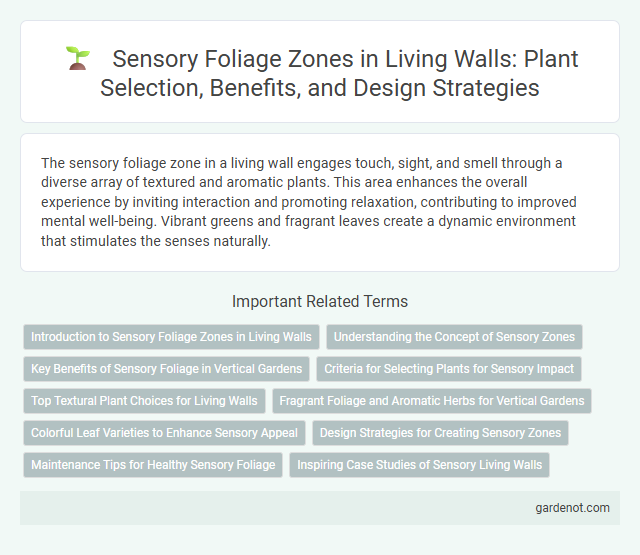The sensory foliage zone in a living wall engages touch, sight, and smell through a diverse array of textured and aromatic plants. This area enhances the overall experience by inviting interaction and promoting relaxation, contributing to improved mental well-being. Vibrant greens and fragrant leaves create a dynamic environment that stimulates the senses naturally.
Introduction to Sensory Foliage Zones in Living Walls
Sensory foliage zones in living walls enhance interaction by incorporating plants with varied textures, scents, and colors to stimulate the senses. These zones often feature aromatic herbs, tactile succulents, and visually vibrant foliage to create a multi-sensory experience. Integrating sensory plants improves wellbeing, encourages mindfulness, and transforms urban spaces into engaging, natural environments.
Understanding the Concept of Sensory Zones
Sensory foliage zones in living walls incorporate diverse plant textures, colors, and scents to engage multiple senses and enhance user interaction. These zones use tactile leaves, aromatic herbs, and visually stimulating greenery to create immersive, therapeutic environments. Integrating sensory zones promotes mental well-being and strengthens the connection between nature and indoor spaces.
Key Benefits of Sensory Foliage in Vertical Gardens
Sensory foliage in vertical gardens enhances air quality by filtering pollutants and increasing oxygen levels, creating a healthier indoor environment. The diverse textures and scents of sensory plants stimulate mental well-being and reduce stress, promoting relaxation and focus. Integrating sensory foliage zones improves biodiversity and supports natural habitats, fostering ecological balance within urban spaces.
Criteria for Selecting Plants for Sensory Impact
Selecting plants for a sensory foliage zone in a living wall requires evaluating tactile, olfactory, and visual attributes to maximize sensory engagement. Plants with varied leaf textures, such as fuzzy lamb's ear or smooth eucalyptus, enhance touch experiences, while aromatic species like lavender and rosemary contribute appealing scents. Vibrant colors and dynamic forms, including the bold reds of coleus or the intricate patterns of calathea, draw visual interest and support multisensory interaction.
Top Textural Plant Choices for Living Walls
Top textural plant choices for living walls in the sensory foliage zone include ferns like Asplenium nidus, which offer broad, wavy fronds that create dynamic visual and tactile interest. Ornamental grasses such as Carex oshimensis provide fine, arching blades that add movement and contrast against denser foliage. Succulents like Echeveria bring rosette shapes and fleshy textures, enhancing the living wall's diversity while thriving in well-drained substrates.
Fragrant Foliage and Aromatic Herbs for Vertical Gardens
Fragrant foliage and aromatic herbs in sensory foliage zones enhance vertical gardens by stimulating the senses with natural scents. Plants such as lavender, rosemary, and mint release essential oils that create a calming environment while improving air quality. Integrating these aromatic species supports biodiversity and provides a multi-sensory experience for urban green spaces.
Colorful Leaf Varieties to Enhance Sensory Appeal
Colorful leaf varieties such as coleus, caladium, and croton significantly enhance the sensory appeal of living walls by providing vibrant hues and varied textures. These plants stimulate visual interest and tactile exploration, creating a dynamic sensory foliage zone. Incorporating diverse foliage colors increases the overall aesthetic and emotional impact of vertical gardens.
Design Strategies for Creating Sensory Zones
Design strategies for creating sensory foliage zones in living walls emphasize selecting plants with varied textures, colors, and fragrances to engage multiple senses. Incorporating tactile foliage like lamb's ear or scented herbs such as lavender enhances touch and smell experiences, while vibrant blooms attract visual attention. Layering plants at different heights and depths optimizes sensory immersion and spatial dynamics within the vertical garden.
Maintenance Tips for Healthy Sensory Foliage
Regular pruning and removing dead or damaged leaves promotes air circulation and prevents fungal growth in sensory foliage zones. Consistent watering tailored to the specific plant species ensures optimal moisture without over-saturation. Using organic mulch and balanced fertilizers supports nutrient absorption, enhancing the vibrant textures and aromas crucial for healthy sensory walls.
Inspiring Case Studies of Sensory Living Walls
Sensory foliage zones in living walls enhance multi-sensory engagement through diverse plant textures, colors, and fragrances, promoting wellbeing and environmental connection. Inspiring case studies include the green walls of Singapore's Changi Airport, which integrate aromatic herbs and soft mosses to create calming public spaces. These examples demonstrate the impactful use of sensory plants to stimulate touch, smell, and sight, enriching urban environments.
Sensory foliage zone Infographic

 gardenot.com
gardenot.com